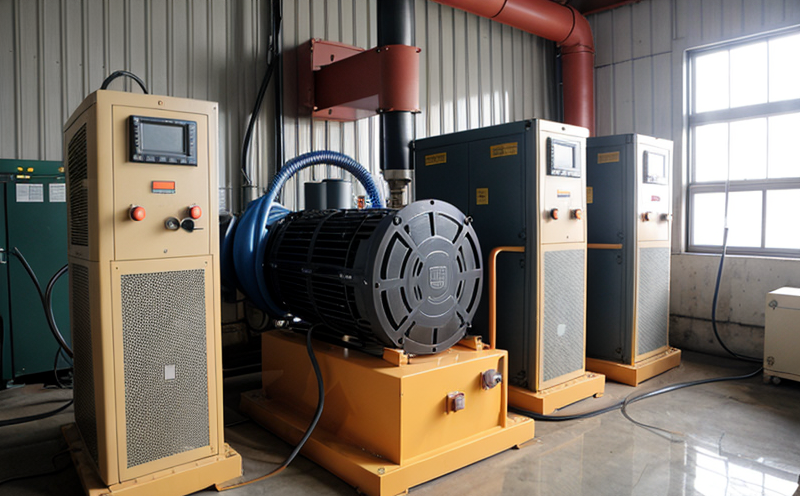IEC 61400-5 Rotor Blade Testing for Power Generation Units
The International Electrotechnical Commission (IEC) Standard IEC 61400-5 is a crucial guideline that ensures the safety and reliability of wind turbine rotors. This standard provides specifications for the design, testing, and installation of rotor blades used in modern power generation units. As quality managers, compliance officers, R&D engineers, or procurement specialists, understanding this standard can significantly enhance your decision-making processes regarding rotor blade performance.
The rotor blades are a critical component of wind turbines; they convert kinetic energy from the wind into mechanical energy that drives the generator to produce electricity. Therefore, ensuring their structural integrity and durability is paramount. IEC 61400-5 addresses various aspects of rotor blade testing, including material properties, structural analysis, fatigue tests, and environmental stress cracking (ESC) evaluation.
One of the primary objectives of this standard is to establish a common basis for assessing the quality of rotor blades. By adhering to IEC 61400-5, manufacturers can ensure their products meet stringent safety requirements, thereby reducing the risk of accidents and extending the operational life of wind turbines. This standard also aids in optimizing design parameters, which ultimately leads to more efficient power generation units.
The testing procedures outlined in IEC 61400-5 are designed to simulate real-world operating conditions that rotor blades might encounter during their service life. These tests encompass static and dynamic loading scenarios, fatigue testing, and ESC evaluation. The standard provides detailed guidance on how specimens should be prepared for these tests, ensuring consistent results across different manufacturers.
Static load testing assesses the maximum stress that a rotor blade can withstand without sustaining permanent deformation or failure. Dynamic load testing evaluates the blade's response to varying wind speeds and directions. Fatigue testing simulates the cyclic loading conditions experienced by blades over their operational life, while ESC evaluation focuses on identifying potential areas where environmental factors like moisture may cause cracking.
Compliance with IEC 61400-5 is not only essential for meeting regulatory requirements but also demonstrates a commitment to quality and safety. This standard plays a pivotal role in ensuring the reliability of wind turbines, which is critical given the increasing global demand for renewable energy sources. By adhering to these standards, manufacturers can build trust with end-users and contribute positively towards environmental sustainability goals.
Moreover, IEC 61400-5 facilitates international trade by providing a harmonized approach to rotor blade testing. This standardization helps reduce barriers between markets and fosters collaboration among stakeholders in the wind energy sector. As a result, it promotes innovation while maintaining consistent quality standards worldwide.
Why It Matters
The importance of IEC 61400-5 Rotor Blade Testing cannot be overstated, particularly within the context of power generation units. Ensuring that rotor blades meet the stringent requirements set forth by this standard is vital for several reasons:
- Enhanced Safety: Compliant testing ensures that rotor blades can withstand extreme conditions without compromising structural integrity.
- Prolonged Operational Life: Rigorous testing helps identify potential weaknesses early, allowing manufacturers to address them before the product reaches market.
- Better Efficiency: Optimized design parameters resulting from thorough testing lead to more efficient power generation units.
- Regulatory Compliance: Adherence to international standards is necessary for meeting legal requirements and avoiding penalties associated with non-compliance.
In summary, IEC 61400-5 Rotor Blade Testing plays a crucial role in enhancing the safety, efficiency, and longevity of wind turbines. By following this standard, stakeholders contribute to both environmental sustainability and economic growth within the renewable energy sector.
Industry Applications
| Application | Description |
|---|---|
| Wind Turbine Manufacturing: | Involves the production of rotor blades that comply with IEC 61400-5 standards. |
| Quality Assurance: | Ensures that all components meet specified quality criteria before assembly into wind turbines. |
| Research & Development: | Supports the development of new materials and designs for rotor blades. |
| Inspection & Maintenance: | Facilitates regular checks on existing wind turbines to ensure ongoing compliance with IEC 61400-5. |
The applications of IEC 61400-5 Rotor Blade Testing are wide-ranging, extending beyond manufacturing into various stages of the lifecycle of wind turbines. Compliance with this standard is essential for ensuring optimal performance and longevity in all these areas.
Why Choose This Test
- Comprehensive Coverage: IEC 61400-5 provides a detailed framework that covers multiple aspects of rotor blade testing.
- International Recognition: Compliance with this standard is recognized globally, enhancing market access for manufacturers.
- Innovation Facilitation: By adhering to these standards, companies can foster innovation and stay ahead in the competitive renewable energy sector.
- Cost Efficiency: Early identification of potential issues through rigorous testing can prevent costly repairs or replacements later on.
- Enhanced Reputation: Demonstrating commitment to quality and safety improves a company's reputation among stakeholders.
- Regulatory Compliance: Ensuring compliance with international standards helps avoid legal pitfalls and penalties.
The advantages of choosing IEC 61400-5 Rotor Blade Testing are numerous, making it an indispensable tool for any organization involved in the design, manufacturing, or maintenance of wind turbines. This comprehensive testing ensures not only regulatory compliance but also enhances overall product quality and reliability.





